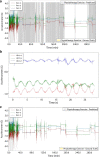Evaluation of at-home physiotherapy
- PMID: 37051835
- PMCID: PMC10032230
- DOI: 10.1302/2046-3758.123.BJR-2022-0126.R1
Evaluation of at-home physiotherapy
Abstract
An objective technological solution for tracking adherence to at-home shoulder physiotherapy is important for improving patient engagement and rehabilitation outcomes, but remains a significant challenge. The aim of this research was to evaluate performance of machine-learning (ML) methodologies for detecting and classifying inertial data collected during in-clinic and at-home shoulder physiotherapy exercise. A smartwatch was used to collect inertial data from 42 patients performing shoulder physiotherapy exercises for rotator cuff injuries in both in-clinic and at-home settings. A two-stage ML approach was used to detect out-of-distribution (OOD) data (to remove non-exercise data) and subsequently for classification of exercises. We evaluated the performance impact of grouping exercises by motion type, inclusion of non-exercise data for algorithm training, and a patient-specific approach to exercise classification. Algorithm performance was evaluated using both in-clinic and at-home data. The patient-specific approach with engineered features achieved the highest in-clinic performance for differentiating physiotherapy exercise from non-exercise activity (area under the receiver operating characteristic (AUROC) = 0.924). Including non-exercise data in algorithm training further improved classifier performance (random forest, AUROC = 0.985). The highest accuracy achieved for classifying individual in-clinic exercises was 0.903, using a patient-specific method with deep neural network model extracted features. Grouping exercises by motion type improved exercise classification. For at-home data, OOD detection yielded similar performance with the non-exercise data in the algorithm training (fully convolutional network AUROC = 0.919). Including non-exercise data in algorithm training improves detection of exercises. A patient-specific approach leveraging data from earlier patient-supervised sessions should be considered but is highly dependent on per-patient data quality.
© 2023 Author(s) et al.
Conflict of interest statement
D. Burns and C. Whyne hold equity in Halterix Corporation, a digital physiotherapy company founded by D. Burns. D. Burns and C. Whyne also report a provisional patent filing for Activity Recognition with Deep Embeddings. P. Boyer reports an Ontario Graduate Scholarship, unrelated to this study. D. Burns reports support for attending meetings and/or travel from Stryker.
Figures






References
-
- Ellenbecker TS. Current Concepts in Rehabilitation of Rotator Cuff Pathology: Nonsurgical and Postoperative Considerations In Miller MD. ed Orthopaedic Knowledge Rosemont, Illinois: American Academy of Orthopaedic Surgeons; 2016. 1 18
-
- Kemp KAR, Sheps DM, Luciak-Corea C, Styles-Tripp F, Buckingham J, Beaupre LA. Systematic review of rotator cuff tears in workers’ compensation patients. Occup Med (Lond) 2011;61(8):556–562. - PubMed

